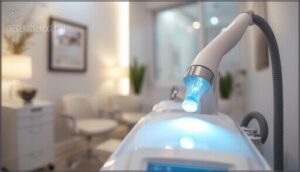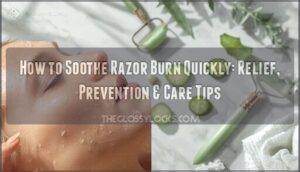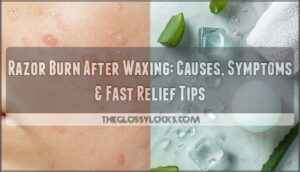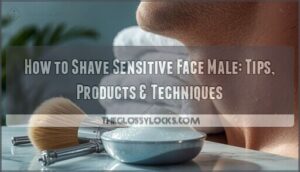This site is supported by our readers. We may earn a commission, at no cost to you, if you purchase through links.
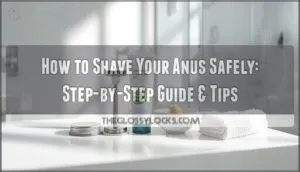 You’re not alone if you’ve felt awkward managing personal grooming below the belt. Nearly 40% of adults now remove body hair in intimate areas, yet most receive zero guidance on safe technique.
You’re not alone if you’ve felt awkward managing personal grooming below the belt. Nearly 40% of adults now remove body hair in intimate areas, yet most receive zero guidance on safe technique.
The perianal region presents unique challenges—sensitive skin, awkward angles, and a higher risk of irritation or infection when handled improperly. Whether you’re preparing for intimacy, seeking comfort, or simply prefer a groomed look, understanding proper method matters.
From shaving and waxing to laser treatments, each approach requires specific preparation and aftercare to protect delicate tissue. Here’s what dermatologists actually recommend for keeping this sensitive area smooth, healthy, and irritation-free.
Table Of Contents
- Key Takeaways
- How to Shave Anus?
- Shaving Butt Hair
- Waxing Butt Hair
- Laser Hair Removal
- Electrolysis
- Risks and Side Effects
- Frequently Asked Questions (FAQs)
- Should you shave hair around the anus?
- Can I use Nair on my anus?
- Is it safe to wax anus hair?
- Does shaving bum hair reduce sweat?
- How often should I shave my anus?
- Can I use regular soap instead of shaving cream?
- Is it safe to shave while pregnant?
- How do I prevent stubble and prickliness after shaving?
- Should I shave in the direction of hair growth?
- Does butt hair grow back thicker after shaving?
- Conclusion
Key Takeaways
- Proper preparation (trimming, warm shower, exfoliation) and using sharp razors with shaving cream designed for sensitive skin cuts irritation risk from 60% to under 2% when removing hair around the anus.
- Shaving provides temporary smoothness for days while waxing lasts 4-6 weeks, laser requires 2-6 sessions for 75% reduction, and electrolysis achieves over 90% permanent removal after 8-20 treatments.
- The biggest risks include razor burn, ingrown hairs (affecting 25% of people), infections from bacteria in the warm moist environment, and burns from improper waxing technique (24% report burns).
- Aftercare matters as much as technique—rinse with cool water, apply alcohol-free moisturizer, wear loose clothing for 24 hours, and skip intense workouts to prevent complications during skin recovery.
How to Shave Anus?
Shaving your anus doesn’t have to feel like steering through a minefield. Start by trimming longer hairs with scissors or a trimmer—it makes the razor’s job easier. Hop in a warm shower to soften hair and open pores, then lather the area with shaving cream designed for sensitive skin. Use a clean, sharp razor and shave gently in the direction of hair growth to avoid razor bumps and skin infections. Rinse thoroughly and pat dry, then apply a soothing, alcohol-free lotion to calm the skin and prevent irritation.
It’s also essential to think about STD risk factors when shaving sensitive areas.
Shaving Butt Hair
Shaving your butt hair doesn’t have to be a nerve-wracking experience if you know what you’re doing. The key is breaking it down into three manageable steps: prep work, the actual shave, and what comes after.
Let’s walk through each one so you can get smooth results without the drama.
Preparing for Shaving
Preparation is essential for shaving your butt safely. Start by trimming longer hair to about ¼ inch using disinfected scissors or an electric trimmer—this prevents razor clogging and gives you better visibility. Next, hop in a warm shower for at least five minutes to soften the hair and open your pores, which makes the whole process smoother. While you’re there, gently exfoliate your butt with a soft scrub or washcloth to lift dead skin cells and reduce your risk of razor bumps later. After your shower, pat the area completely dry with a clean towel. Using a sharp razor technique is vital for a gentle and safe shave.
Here’s your prep checklist:
- Trim hair to ¼ inch with clean tools
- Soak in warm water for 5+ minutes
- Exfoliate gently to prevent ingrown hairs
- Use a pH-balanced cleanser to reduce bacteria
- Pat dry and position a mirror for visibility
Proper skin preparation and hygiene practices set you up for success when you’re ready to shave your anus. Choose an aloe-based shaving cream for lubrication, and consider using a dedicated razor for this sensitive area to avoid cross-contamination.
Shaving Techniques
Once you’re prepped, it’s time to master shaving techniques that keep you safe. Position yourself comfortably—squat or prop one leg up—and use a handheld mirror for clear visibility. Apply a generous layer of shaving cream for smooth razor glide, then pull your skin taut with your free hand. Shave in the direction of hair growth using slow, short strokes to minimize razor bumps and irritation. Rinse your blade after every pass to prevent bacteria buildup.
Your shaving safely toolkit:
- Razor Selection – Use a sharp, clean blade (replace every 5-7 uses) and consider a dedicated razor for this sensitive area.
- Shaving Creams – Choose hypoallergenic, aloe-based formulas that protect while you shave your anus.
- Skin Preparation – Keep skin taut and work methodically from bottom to top, inside to out.
Over 89% of people prefer manual razors for shaving your bum, and dermatologists agree—proper technique beats expensive tools every time.
Aftercare
Once your shave’s complete, smart postshave care protects your skin from irritation and infection. Up to 62% of people experience redness within 30 minutes, so act fast. Pat the area dry, then wait five minutes before getting dressed—air-drying cuts moisture-related dermatitis risk markedly. Apply a thin layer of fragrance-free moisturizer containing shea butter or arnica, which reduces irritation by 40%.
Here’s your skin recovery checklist:
- Rinse with cool water – Closes pores and soothes freshly shaved skin
- Apply alcohol-free moisturizer – Hydrates without stinging (use pea-sized amounts)
- Wear loose, breathable clothing – Reduces friction by 41% compared to tight fabrics
- Skip intense workouts for 24 hours – Prevents chafing during skin recovery
- Monitor for infection signs – Watch for unusual redness, bumps, or warmth
Following these shaving safety tips drops your infection risk from 5.6% to under 2%. That’s the difference between smooth confidence and a week of regret.
Waxing Butt Hair
Waxing offers longer-lasting results than shaving, but it requires some preparation and courage. The process pulls hair from the root, which means you’ll stay smooth for weeks instead of days.
Here’s what you need to know before your first wax and what happens during the appointment.
Preparing for Waxing
Proper skin preparation for waxing hair removal can reduce irritation by over 40%. Start by cleansing the anal area with a gentle, fragrance-free wash—this hygiene protocol removes surface bacteria and optimizes wax adhesion. Exfoliation techniques matter too: gently scrub the area 24–48 hours before your appointment to clear dead skin cells and cut ingrown hairs by nearly half. Hair length is vital; let growth reach about a quarter-inch (stop shaving 1–2 weeks prior) for the best results.
Here’s your pre-wax checklist:
- Take ibuprofen 30–60 minutes before to ease discomfort
- Skip oils, lotions, and creams on waxing day—they interfere with adhesion
- Wear loose, breathable clothing to your appointment
Following these hair removal preparation steps ensures a smoother waxing process and healthier skin afterward.
The Waxing Process
Once the wax hits your skin, expect a quick but efficient process. A licensed professional applies a pre-wax cleanser for sanitation practices, then spreads hard wax—designed for sensitive areas—in small sections across the buttocks. The wax adheres to hair, not skin, which greatly reduces discomfort. When it cools, they pull it off swiftly against the direction of hair growth, removing hair from the root. The entire waxing process takes about 15–20 minutes, and you’ll enjoy smoother skin for up to six weeks compared to shaving’s fleeting results.
Here’s what makes professional hair removal effective:
- Skin preparation with cleansers lowers infection risk and improves wax application
- Regrowth patterns shift over time—hair becomes finer and sparser with repeated sessions
- Post-wax care includes soothing gel to calm redness and promote healing
Laser Hair Removal
Laser hair removal offers a long-term solution if you’re tired of the shave-and-repeat cycle. The process uses concentrated light to target hair follicles, reducing growth over time.
Here’s what you need to know before booking your first session and what happens during treatment.
Preparing for Laser Hair Removal
Laser hair removal for your intimate areas demands careful pre-treatment care to protect your skin and boost results. Skin type assessment is critical—darker tones require specialized devices to prevent burns or pigmentation issues. Stop sun exposure and self-tanners two weeks beforehand, as tanned skin increases complication risks markedly. Medication considerations matter too: photosensitive drugs like certain antibiotics need a two-week break, while Accutane requires waiting six months. Shave 24–48 hours before your session (not wax—the laser needs intact roots), and arrive with clean, product-free skin.
Here’s your laser prep tips checklist:
| Action | Timing | Why It Matters |
|---|---|---|
| Stop waxing/plucking | 4+ weeks before | Preserves hair roots for targeting |
| Avoid sun/tanning beds | 2 weeks prior | Prevents burns, photosensitivity |
| Discontinue retinol/acids | 2–3 days ahead | Reduces irritation risk |
Proper pre-treatment care, considering hair growth phases, ensures safer, more effective permanent hair removal.
The Laser Hair Removal Process
Think of laser hair removal like a precision mission—each pulse targets and neutralizes hair follicles with controlled energy bursts. Here’s what happens during your session:
- Protective measures: You’ll wear goggles while your provider adjusts laser settings based on your skin tone to prevent burns or pigment changes.
- Cooling comfort: A chilled gel or air-cooling device minimizes heat on your skin’s surface during treatment.
- Targeted pulses: The laser delivers wavelengths (commonly 755–1064 nm) with pulse durations of 1–10 milliseconds, creating follicle damage that disrupts growth.
- Session completion: Most treatments last minutes to an hour, with immediate return to activities possible.
You’ll need 2–6 sessions spaced weeks apart for 75% hair reduction—true permanent hair removal takes patience and precision.
Electrolysis
Electrolysis offers a permanent solution for butt hair removal, though it requires patience and commitment. The process destroys hair follicles one by one using a fine needle and electrical current.
Let’s walk through what you need to know before your first session and what happens during the procedure itself.
Preparing for Electrolysis
Electrolysis can feel like stepping into uncharted territory, but proper skin preparation makes all the difference. You’ll need to stop plucking or waxing at least 2-3 weeks before your session—the root must be intact for effective permanent butt hair removal. Light shaving 3-5 days prior is fine, but skip it 24 hours before your appointment to minimize irritation. Hydrate well by drinking plenty of water 48 hours ahead, and moisturize daily to keep your skin supple. On treatment day, shower thoroughly and arrive with clean, product-free skin.
Here’s what preparing for electrolysis looks like:
| Preparation Step | Timeline | Purpose |
|---|---|---|
| Stop plucking/waxing | 2-3 weeks before | Preserve hair roots |
| Shave if needed | 3-5 days prior | Ideal hair length |
| Hydrate skin | 48 hours before | Boost treatment efficacy |
| Discontinue retinoids | 3-7 days before | Reduce sensitivity |
| Cleanse thoroughly | Day of session | Lower infection risk |
Discuss electrolysis costs and any medications during your initial consultation—transparency about pre-session tips and your aftercare routine helps guarantee the smoothest experience possible.
The Electrolysis Process
Permanent hair removal feels like a promise finally kept—and that’s exactly what electrolysis delivers. During each session, your electrologist inserts a fine, sterile needle into individual hair follicles. A mild electrical current then destroys the follicle at its root, preventing regrowth. This electrolysis process achieves over 90% permanent results across all skin types and hair colors.
Here’s what to expect:
- Session length: Each appointment lasts 15–60 minutes, depending on treatment area size.
- Treatment cycle: You’ll need 8–20 sessions spaced weeks apart to target hair during its active growth phase.
- Immediate effects: Temporary redness and mild swelling resolve within 1–2 days.
Electrolysis cost ranges from $25–$50 for smaller areas, making it cost-effective long-term compared to repeated hair removal methods. Skin preparation and choosing a licensed professional minimize infection risk and guarantee the smoothest electrolysis benefits.
Risks and Side Effects
Every hair removal method comes with potential downsides you should know about before you start. Understanding what can go wrong helps you decide which approach works best for your body and how to minimize problems.
Let’s look at the main risks for shaving and waxing.
Shaving
Shaving your anus carries real risks you should know about. While it’s cost-effective and convenient, the technique refinement and razor selection matter more here than anywhere else. Studies show around 60% of people who shave this area experience complications—not to scare you, but to help you prepare. Safe shaving techniques start with understanding what can go wrong.
Here’s what you’re up against:
- Razor burn and irritation: That burning sensation happens when you shave too aggressively or skip proper prep. Your skin here is thinner than you’d think, making it vulnerable to friction damage.
- Ingrown hairs: About one-quarter of grooming injuries involve these painful bumps. They occur when hair curls back under your skin, especially if you shave against the grain. Ingrown prevention means adjusting your shaving frequency—less is often more.
- Cuts and infections: The warm, moist environment creates a perfect breeding ground for bacteria. Even tiny nicks can lead to folliculitis or worse. Product recommendations? Use fresh razors and antiseptic aftercare.
Waxing
While shaving brings its share of trouble, waxing butt hair introduces different challenges. The waxing benefits sound appealing—you’ll stay smooth for weeks instead of days—but the risks deserve your attention. Clinical data shows waxing injuries have jumped fivefold in the past decade, with most involving burns and infected follicles.
Here’s what you’re facing:
- Burns and skin damage: Overheated wax causes second-degree burns in some cases. Around 24% of patients report burns after professional waxing, and at-home waxing carries even higher risk without proper temperature control.
- Infection complications: About 10% of waxing injuries involve bacterial infections. Your anus area’s warmth and moisture create ideal conditions for cellulitis or folliculitis once hair follicles open.
- Pigmentation changes: Darker skin types face 15-20% risk of lasting discoloration after waxing the anus.
Pain management matters—this won’t feel pleasant. Professional waxing offers better wax types and technique, reducing your complication odds compared to DIY attempts.
Frequently Asked Questions (FAQs)
Should you shave hair around the anus?
Here’s the thing: removing hair around your anus is entirely up to you. There’s no medical requirement.
If hygiene benefits or aesthetic appeal matter to you, anus hair removal tips can help you do it safely.
But trimming offers comfort without the risks that come with shaving butt hair completely.
Can I use Nair on my anus?
Skip Nair and depilatory creams for your anus—their high pH (12-13) can cause chemical burns and severe irritation on sensitive skin.
That area has delicate mucous membranes that react badly to harsh thioglycolates.
Try trimming or careful shaving instead.
Is it safe to wax anus hair?
Let’s cut to the chase: waxing your anus can be safe, but professional waxing is key. It’s more intense than shaving but offers smoother results for four to six weeks.
Hygiene practices matter—proper cleansing reduces infection risk. If you have medical conditions or take immunosuppressants, consult your doctor first.
Adverse reactions like redness affect roughly 15-26% of people, so aftercare counts.
Does shaving bum hair reduce sweat?
You might notice less moisture initially, but shaving won’t cut down on actual sweating—your sweat glands keep working the same.
Hair helps wick moisture away from skin, so removing it can trap sweat against your perianal area, potentially increasing bacterial odor and affecting your skin microbiome and hygiene.
How often should I shave my anus?
Your personal regrowth timeline dictates shaving frequency—usually every 3 to 5 days for most people. Hair becomes stubbly within a week after shaving your anus, so adjust based on what you see and feel.
Prioritize irritation prevention over aggressive schedules; daily shaving strips natural oils and invites trouble.
Can I use regular soap instead of shaving cream?
You can use regular soap, but it’s not your best bet. Soap ingredients—especially harsh detergents—strip natural oils, leaving sensitive skin dry and prone to razor burn, nicks, and ingrown hairs.
Shaving cream or shaving gel offers better glide and protection for this delicate area.
Is it safe to shave while pregnant?
Shaving during pregnancy is safe with proper precautions, though hormonal skin changes increase sensitivity and infection risk factors. Your growing belly creates shaving accessibility challenges—use a clean, sharp razor, fragrance-free cream, and consider trimming instead for sensitive skin and easier post-shave hygiene.
How do I prevent stubble and prickliness after shaving?
Think of stubble like a Victorian gentleman’s five o’clock shadow—unavoidable but manageable.
Exfoliate two to three times weekly before your pre-shave routine to free trapped hairs. Use a sharp razor with proper blade sharpness, shave in the direction of hair growth, then moisturize immediately with aloe or glycerin-based products for effective aftercare that softens regrowth and prevents razor bumps.
Should I shave in the direction of hair growth?
Yes, always follow your hair growth patterns when shaving sensitive areas. Dermatologist recommendations emphasize this approach to minimize follicle trauma and ingrown hair prevention.
Going with the grain protects your skin from irritation, even if closeness suffers slightly.
Does butt hair grow back thicker after shaving?
No, shaving butt hair won’t make it thicker or darker—that’s a common myth. The blunt hair tip after shaving creates a regrowth illusion.
Your hair follicle structure and genetic factors determine growth, not your razor.
Conclusion
Here’s the truth: learning how to shave anus safely transforms an intimidating task into routine self-care. You’ve now got the tools—proper razors, smart positioning, gentle aftercare—to avoid the nicks, bumps, and regret that come from winging it.
Whether you choose shaving, waxing, or professional removal, technique trumps speed every time. Your skin will thank you for the patience.
Start with one method, master the basics, and adjust as you learn what works. Confidence grows with practice, not infallibility.
- https://medicine.yale.edu/profile/mona-gohara/
- https://www.ncbi.nlm.nih.gov/pmc/articles/PMC3535073/
- https://www.webmd.com/skin-problems-and-treatments/guide/ingrown-hair-causes-symptoms-treatment
- https://pmc.ncbi.nlm.nih.gov/articles/PMC5710443/
- https://arstechnica.com/science/2017/08/rare-pubic-grooming-data-reveals-injuries-odd-habits-and-nicked-bits/



